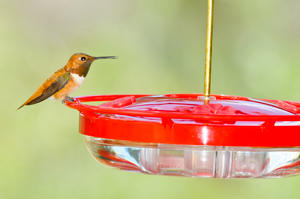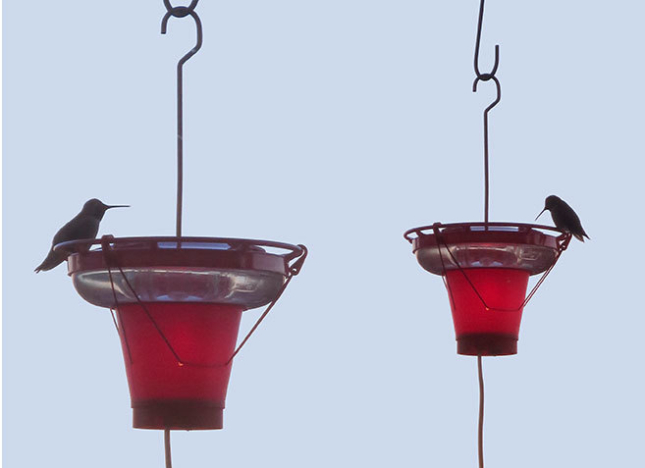Keep Your Hummingbird Feeders Thawed
with the Hummer-Hearth!
With this simple, elegant design, your hummingbirds will always find fresh nectar…Using the Hummer-Hearth, air is gently warmed under your hummingbird feeders, keeping the nectar from freezing. The housing easily clips to the perch of many hummingbird feeders with an adjustable elastic cord. Powered by a 7-watt bulb, the 36” long exterior-rated electrical cord plugs into your outdoor extension cord. And it costs just pennies a day to use.
Anna’s Hummingbirds stay all winter here in the Pacific Northwest, getting nectar from winter-blooming native plants and also eat tiny insects, their eggs or other tiny leaf-crawling insects. After waking from their nightly torpor, they arrive at our feeders as mush as an hour before sunrise. With the Hummer-Hearth, there’s no need for you to bring the feeder in at night and get up really early to put it back out.
Designed by a local engineer who loves hummingbirds, the Hummer-Hearth’s simple design lets you rest easy on these frigid nights, knowing your little friends will be well cared for as you sleep.
Hummingbird Feeders
Hummingbird Feeders are designed to offer fresh nectar in ways that hummingbirds can easily forage. Most hummingbird feeders we carry have built-in ant moats to keep insects out and they have feeding ports that prevent rain water from diluting the nectar solution. They’re easy to hang or pole-mount and easy to clean.
Hummingbirds are among the smallest of creatures...but don't let that fool you into thinking they're fragile! Found only in North, Central and South America, hummingbirds weigh less than an ounce (about the weight of a penny), migrate immense distances, and are the only birds that can hover and fly backwards.
Our summer-visiting Rufous Hummingbirds breed here in summer and leave in late summer. They are the only male hummingbirds that are a rufous(rusty)-brown and white with a red gorget. But year-round we have the Anna's Hummingbird, and they have adapted to tolerate very cold weather.

Hummingbirds & You
Hummingbirds have fantastic memories, and are capable of remembering where flowers and feeders were found previously... even a year earlier, in the case of our summer-resident Rufous Hummingbirds. They return to the exact spot they found food previously upon their return in Spring. If they don't find a feeder there, they will continue on until they find food.
Hummingbirds, especially our Anna's and Rufous species, are ounce-for-ounce some of the fiestiest little birds. They will claim (i.e.protect) as many feeders as possible and keep busy chasing away all other hummingbirds. If this happens to your yard, the best solution is to hang multiple feeders, making sure that the resident hummer cannot see all feeders at one time. This will allow other birds a chance to feed. One Eugene resident hummingbird-lover has up to 30 feeders out and the birds do not then try to defend them all. No one male could possibly do so, and their behaviour changes in such situations.
Making Nectar
Do NOT adjust the sugar water mix regardless of the weather conditions. Keep the mix at 1:4 ratio sugar to water...even in winter.
Nectar concentrations vary greatly among a variety of plants hummingbirds visit, but they are typically low in sugar. Recipes with a higher concentration of sugar do not necessarily benefit hummingbirds because it cannot travel up the grooves of their tongue easily and may also damage kidneys and liver. Though increasing the sugar may help prevent the nectar from freezing, our experts recommend staying consistent with a 1:4 mix. White sugar and water only; definitely NO honey, brown sugar, maple syrup etc. Pure sucrose is what they need to survive. We do NOT recommend ever using red dye either, since there is no research that indicates if its safe and there IS evidence that the dye can cause liver or kidney damage.
RECIPE: A simple recipe of 1 part sugar and 4 parts water, mixed in a glass measuring cup, (and if saving some for later use, do boil water before adding sugar), is the ONLY mixture you should feed them. Never add other ingredients! Hummingbirds are great at surviving as they have been. Anything you add could actually cause them harm!
Do set it out when cool. You may store extra in the fridge up to two weeks. Clean your feeder/s once a week during cold weather, and do so every 2-3 days during warmer weather.
Picking the Correct Feeder
With so many feeders on the market, it can be confusing to choose one that is best for you. The answer is very simple; chose one that you can clean easily (thus often) and that doesn't leak.
Avoid "pretty" feeders that have a glass down-spout. These will usually leak and can cause either an ant invasion or just makes a real mess. Also avoid feeders that have lots of small crevices or corners. These will be impossible... or a real pain... to clean.
The best feeders are basin or saucer style. These feeders have a flat bottom and a top that simply lifts off — no crevices to trap old solution. Most are made from a durable, polycarbonate that resists fading from UV exposure, and which does not off-gas like cheaper plastics, and the roof will stay red, which attracts the hummingbirds, for years. A basin feeder will not leak and usually has perches for the birds to use while feeding. Studies have found that if a hummingbird can perch, they will feed longer (as long as they don't feel the need to constantly patrol every feeder!)
Top: Rufous Hummingbird at High Perch Feeder. Above: two feeders with attached Hummer-Heaters.


